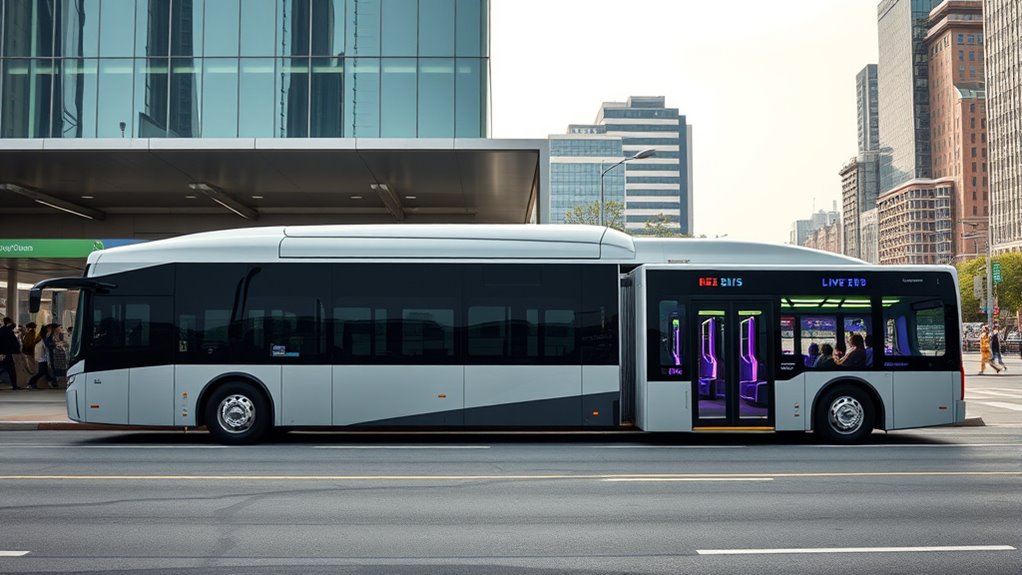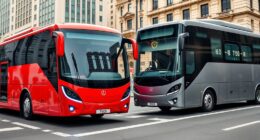Intercity electric buses are designed for longer trips, prioritizing larger batteries, extended range, and passenger comfort, with features supporting less frequent recharging. Urban electric buses focus on high-frequency routes within cities, offering quick turnarounds, high passenger capacity, and smaller batteries suited for short trips. Their design enables efficient operation in dense environments. If you want to understand how these differences influence performance and infrastructure, keep exploring the key aspects that set them apart.
Key Takeaways
- Intercity buses prioritize larger batteries and extended range, while urban buses focus on quick turnaround and high passenger capacity.
- Charging infrastructure for intercity buses requires fast chargers or battery swapping stations, unlike urban buses with depot and rapid charging stations.
- Interior layouts differ: intercity models emphasize passenger comfort over longer trips, whereas urban buses maximize seating and standing room for high-density use.
- Vehicle size varies: intercity buses are larger with fewer seats, and urban buses are more compact, agile, and suited for dense city streets.
- Deployment strategies differ: intercity buses need long-range infrastructure, while urban buses rely on frequent stops, depot charging, and high-capacity routes.

Electric buses are transforming transportation, but their design and deployment differ considerably depending on whether they’re used for intercity or urban routes. When it comes to intercity buses, the focus is on maximizing range and efficiency over longer distances. These buses often require advanced charging infrastructure, such as fast chargers or even battery swapping stations, to minimize downtime during stops. The goal is to guarantee they can travel between cities without frequent recharging, so their batteries tend to be larger and more robust. This means they can carry more energy, but it also impacts passenger capacity. Intercity electric buses generally prioritize longer range over maximum passenger capacity, which can result in a slightly more spacious interior with fewer seats to make room for larger batteries. Still, they need to accommodate enough passengers to be economically viable, so their design balances battery size with seating arrangements, often featuring fewer seats than traditional diesel counterparts but with added amenities for comfort on longer journeys. Additionally, the development of credit card processing infrastructure for ticket sales and onboard purchases is essential for modern intercity electric bus networks, streamlining operations and enhancing passenger experience.
In contrast, urban electric buses are designed to operate within city limits, where frequent stops, short distances, and high passenger volumes are common. Here, the charging infrastructure plays a critical role in maintaining service continuity. Urban routes often benefit from depot charging, where buses recharge overnight or during scheduled layovers, and some cities are integrating rapid charging stations at key stops to allow quick top-ups during the day. Since these buses typically complete multiple short trips daily, their batteries are smaller, which helps keep the vehicle lighter and more agile in crowded streets. Passenger capacity becomes a primary concern for urban buses—these vehicles are built to maximize the number of passengers they can carry, often featuring standing room and high-capacity seating layouts. This ensures that they can serve dense populations efficiently, reducing the number of vehicles needed and easing traffic congestion.
Both types of electric buses share the common goal of reducing emissions and operational costs, but their design choices reflect their unique operational needs. Intercity buses prioritize range and passenger comfort over shorter stops, requiring significant charging infrastructure investments and larger batteries. Urban buses focus on high-frequency service, rapid turnarounds, and high passenger capacity, which influences their size, battery capacity, and charging strategies. Understanding these differences helps transit agencies make informed decisions about technology, infrastructure, and vehicle design, ensuring that electric buses meet the demands of their specific routes efficiently. Whether you’re planning a long-distance fleet or a city-wide transit system, tailoring your deployment strategy to these distinctions maximizes benefits and operational success.
Frequently Asked Questions
How Do Charging Times Differ Between Intercity and Urban Electric Buses?
Charging times for intercity electric buses tend to be longer because they require more extensive charging infrastructure and advanced battery technology to cover longer routes. Urban buses usually charge faster at designated stations since their batteries are smaller and charging stations are more accessible. You’ll find that urban buses often use fast chargers, reducing downtime, whereas intercity buses may need overnight charging or rapid charging stations to stay operational.
What Safety Features Are Unique to Intercity Electric Buses?
You’ll notice intercity electric buses have unique safety features like advanced autonomous systems that help with navigation and collision avoidance. They also come equipped with enhanced emergency protocols, such as automatic brake systems and real-time communication with control centers. These features guarantee passenger safety over long distances and high-speed routes. Unlike urban buses, their safety measures prioritize stability and proactive responses, making your journey safer and more secure.
How Does Passenger Capacity Vary Between the Two Bus Types?
You’ll find that passenger capacity varies markedly between intercity and urban electric buses. Intercity buses often have a larger passenger volume, accommodating more travelers with spacious seating arrangements and standing room, making them like moving stadiums. Urban electric buses, on the other hand, prioritize quick boarding and alighting, with more compact seating. This means they usually carry fewer passengers but are optimized for frequent stops and high passenger turn-over.
Are There Different Maintenance Requirements for Intercity Versus Urban Electric Buses?
You’ll find that maintenance requirements differ mainly due to usage patterns. Urban electric buses often face higher tire wear from frequent stops, while intercity buses need regular checks on battery degradation due to longer trips. Both require routine inspections of brakes and electrical systems. However, urban buses may need more frequent tire replacements, whereas intercity buses focus on monitoring battery health to guarantee the best performance over longer distances.
What Are the Environmental Impacts of Each Bus Type Over Their Lifespan?
You’ll find that both bus types help reduce emissions, but urban buses often contribute more to local air quality improvements due to frequent stops and short routes, while intercity buses impact the environment through longer trips. Over their lifespan, proper battery recycling is vital for both to minimize environmental harm. By adopting these practices, you support emission reduction and guarantee sustainable transportation, benefiting the environment and public health.
Conclusion
While intercity buses prioritize long-distance comfort and larger ranges, urban electric buses focus on quick acceleration and frequent stops. You might find yourself appreciating the smooth ride of an intercity bus, yet also valuing the agility of an urban one maneuvering busy streets. Both serve distinct purposes—intercity connecting regions, urban buses keeping cities moving. Recognizing these differences helps you choose the right vehicle, balancing efficiency with passenger experience in every journey.









